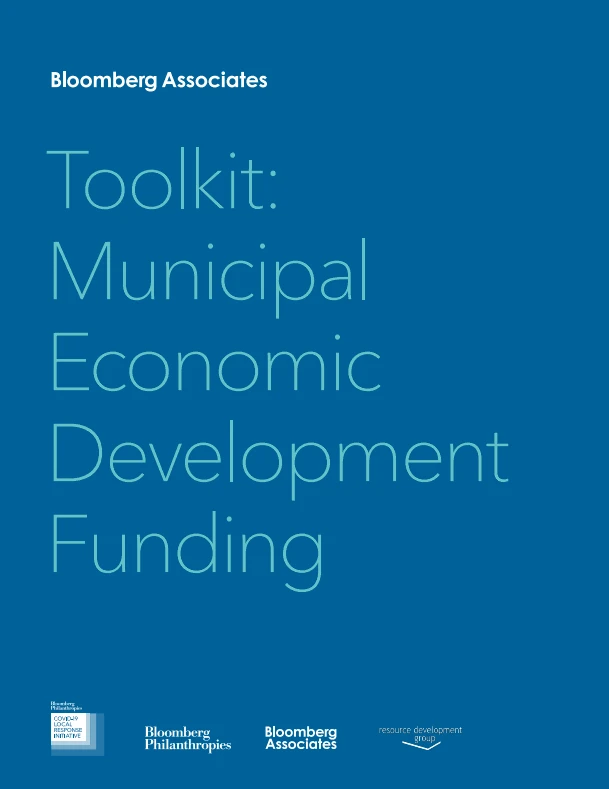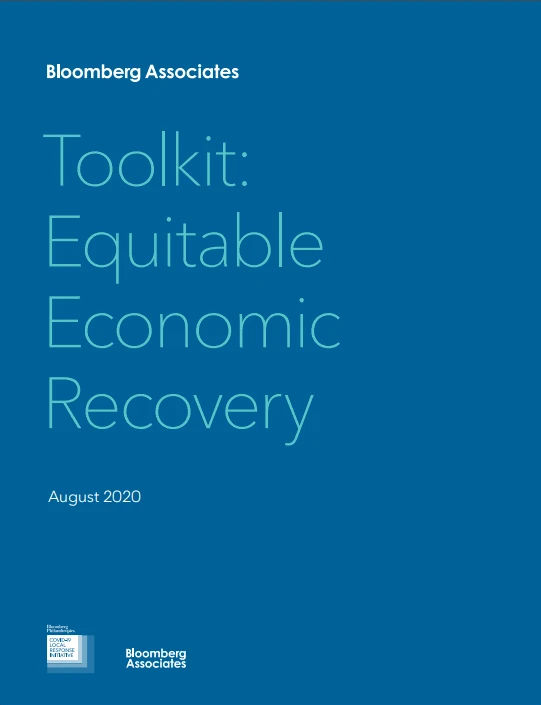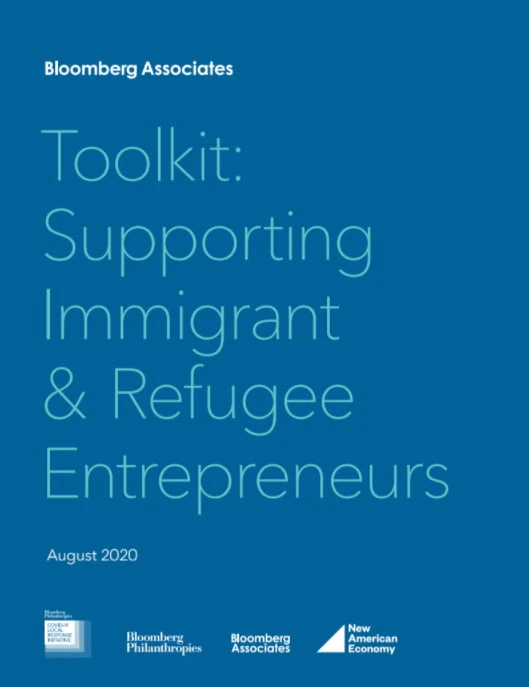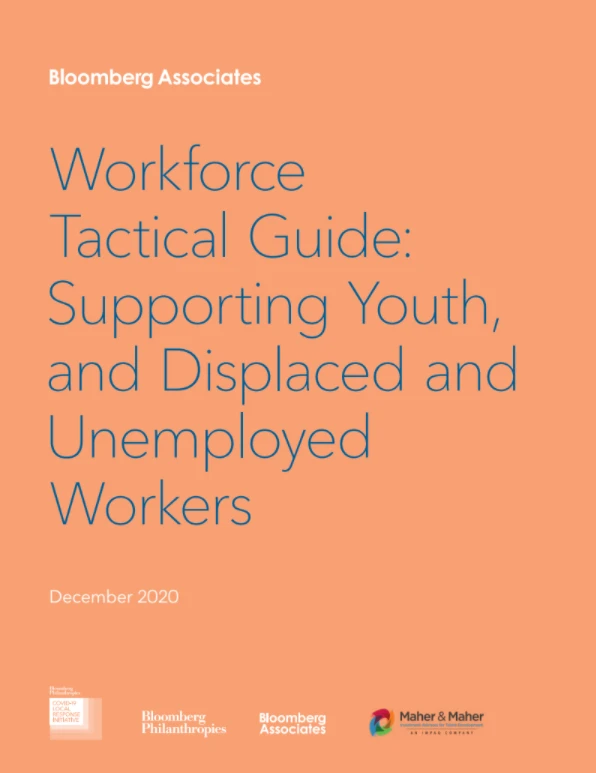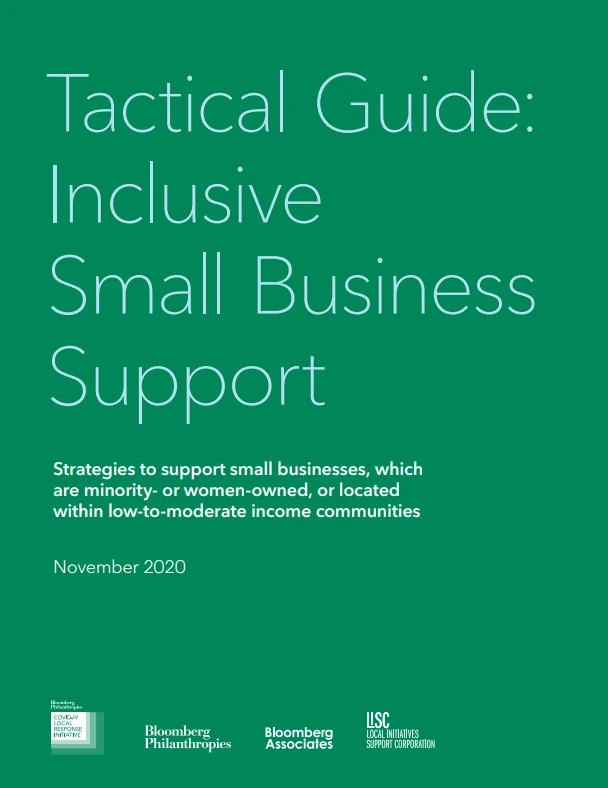COVID-19 Economic Response and Recovery
Outsource programming to a local chamber, business, or other organization to improve delivery and cost savings
Action:
Cities should revisit their economic development programming to see if it would be cheaper to use vendors for particular programs.
Why:
It can be sometimes cheaper and/or more effective to hire a third party to deliver your programming. This can be a public-private partnership, which leads to both cost-savings and greater community support.
The practice of outsourcing is similar to, but not the same as, the more common practice of cities contributing to a regional economic development marketing organization, that then pools these funds with private sector resources to deliver larger-scale campaigns and programs.
Cities have successfully used outsourcing to deliver:
- Regional branding and marketing
- Local business retention and expansion programs
- Proposal preparation
- Prospect lead identification
- Inbound and outbound business recruitment missions (both planning and execution)

Case Study
Oklahoma City
Oklahoma City outsources components of its economic development programming to the Oklahoma City Chamber of Commerce.
The parties agree to an annual contract for services, with rigorous reporting requirements and proper oversight. This contract, which can be found in Appendix N, is an excellent example of a comprehensive engagement agreement, containing all key elements needed to define the relationship.
The arrangement was put in place during a period of economic turbulence. The leadership was provided by the mayor and the leaders of local companies, like Kerr-McGee, Devon Energy, Chesapeake Energy, Oklahoma Gas and Electric, and Opubco.
They agreed that the city should focus on infrastructure and public improvements, while the Chamber should deliver branding, marketing, and business recruitment, retention, and expansion.
Critical to the arrangement were a very high level of trust, aligned vision and goals, and shared commitment to partnership.
The chamber subsequently led a successful campaign to win residents’ approval for the city’s MAPS programs for public improvements (see case study referenced in “Reallocating Funding” Section).
The relationship between the city and chamber has evolved over two decades and changes in leadership, but it continues to be based on a shared vision for the community.
Impact:
The chamber leverages a 4:1 return on city funding, with contributions from private corporations and local foundations.
A portion of the funding has been used to deliver four MAPS campaigns, which have delivered more than $3 billion in public improvements.
How to Adapt this Approach
- Undertake an analysis of program returns on investment and potential cost savings. (Note: this will be challenging if program owners report only activities delivered, and not outputs and impact).
- Identify potential organizations which have the experience and capacity to deliver the programs.
- Draft a request for proposals which clearly defines the scope of work, output-focused key performance indicators (not activities delivered), and how the organization will be expected to engage the City.
- Create a contract for service that clearly outlines roles, responsibilities, and expectations.
- Require a say in the recipient organization’s governance arrangements (e.g., board observer, quarterly reporting, step in audit rights, etc.). In all likelihood, the city will become the recipient’s largest funder. As such, it is appropriate for the city to have a role in governance and oversight.
- Make sure the contract includes output focused key performance indicators, with agreed definitions and metrics and clear milestones.
If the recipient is likely to be a chamber of commerce, or free-standing economic development corporations, satisfy yourself that the organization:
- Has a credible track record of success.
- Has performed at a high level over a long period of time.
- Will be viewed by stakeholders and residents as credible and apolitical.
- Will be able to deliver the program more effectively.
- Will be able to leverage third-party funding for the program.

Do:
- Collaborate with organizations that you trust.
- Be very clear on your expectations regarding deliverables, key performance indicators, metrics and reporting.
- Agree on a process and chain of command for decisions and communications.
- Schedule regular update meetings to discuss progress/roadblocks and issues.
- Keep councilmembers and administrators regularly informed.
Don’t:
- Don’t let cost savings be the only driver in deciding whether or not to outsource. You must also trust that the vendor can do the job effectively.
- Don’t expect the vendor to know about challenges/issues that you have experienced in previous years. If there are skeletons in the closet, disclose these before contracting.
- Don’t forget that you may be the organization’s largest single source of funding. That means the impact of the relationship goes beyond the parameters of the contract. It is in your interest to ensure the recipient remains financially viable and civically responsible.
COVID-19 Economic Response and Recovery
Issue Municipal Bonds to Offer Community Loans
Background:
Access to capital is one of the biggest challenges facing low-income people and communities of color. This problem is particularly acute for minority-owned businesses, which face greater challenges accessing capital than white-owned businesses. It also is a problem for people of color looking to obtain mortgages and grow wealth. Black Americans are denied loans at a disproportionately higher rate with some research showing they are denied at twice the rate of white Americans.
Current criteria for issuing loans include determining if people in the applicant’s social networks pay back loans on-time. Even when people of color are granted mortgages, they often end up paying more than their white peers. This impacts their ability to start businesses and obtain mortgages to buy homes and build wealth. And banks are hesitant to issue loans to small businesses without capital and individuals without an established credit history.
Action:
Cities should consider issuing bonds for the explicit purpose of backing and facilitating access loans for local businesses and mortgages for people who would otherwise not have access to financing. By issuing municipal bonds, cities could bring significant capital to be deployed directly to residents and businesses, using objective scoring driven by the city’s policy goals.
While cities are under enormous financial pressure which makes the issuance of additional bonds challenging, research has shown that increased spending during a recession is the most effective way to rebound.
Cities can either issue the loans directly or work with small local banks or CDFIs to do so. Cities will have to be cautious with implementation. Financial counseling will be necessary to ensure that accessing additional funds is right based on each individual’s circumstances, and a city may not have the requisite financial expertise to implement the program.

How To Adapt this Action:
Although a model doesn’t yet exist for this program, this action draws on a proposal for A Homestead Act for the 21st Century by Professor Mehrsa Baradaran from University California at Irvine.
Based on this proposal, cities should follow the steps below:
- Evaluate needs in disinvested communities
- Host community forums and survey people who would want to start a business with available funding
- This outreach must focus on low-income and communities of color.
- Determine how to issue loans to companies
- Cities can directly issue the loans, but this will require significant financial expertise.
- Alternatively, cities can work with local banks and financial institutions (e.g., Black-owned banks, credit unions) and provide backing for loans to be issued to low-income and communities of color based on relevant criteria.
- Neither model means that cities or banks should issue risky loans. Instead, they can prioritize criteria that are indicators of success (e.g., sound business plan, identified service gaps in communities), over ones that often cause Black and other minority-owned businesses to be rejected for funding at higher rates (e.g., lack of credit history).
- Explore potential partners for action to maximize impact and minimize risk
- Many philanthropic partners are dedicated to increasing access to capital for minority-owned businesses. Some may be willing to match funds.
- Minimize risk by seeing if local non-profits, education institutions, community leaders, and businesses will serve as guarantors on loans.
- Determine criteria for issuing loans to businesses and individuals
- Do not use an applicant’s social network to determine loan eligibility. Instead, focus on non-discriminatory factors (e.g., history of paying bills on-time, strength of business plan).
- Engage non-profits, CDFIs, and other community-based organizations to identify gaps in traditional lending sources.
- Launch pilot with alternative funding source (e.g., not municipal bond) to demonstrate effectiveness of loan offerings
- Given the unique nature of offering loans based on a separate set of criteria, a city should launch a smaller pilot (e.g., loans to 5-10 businesses based on the new scoring criteria) to demonstrate success.
- Consider type of bond issuance
- Although revenue bonds, tied to businesses’ potential revenue, may make sense given the bond’s purpose, cities should decide what type of bond issuance (e.g., general obligation bond) makes the most sense given their unique financial circumstances.
- Review and follow the rules set out by the Municipal Securities Rulemaking Board.
- Note: these rules are relevant for all municipal bond issuances.
- Work with city council to obtain approval for bond issuance
- It will be critical to get your city council’s backing for this project. Using researched alternative criteria should not lead to a lower default rate, but there is always inherent risk when issuing loans. Having the support of your city council and Mayor for this will ensure that you are not criticized in the short-term if there are loan repayment issues.
- Leverage pilot findings to show the potential impact of the full bond issuance.
- This bond issuance can help facilitate access to funding for several populations, including:
- Low-income, Black, and other residents of color who need homeowner loans
- Mid-size business support loans (as proposed in this toolkit)
- Note: local circumstances will dictate how loans can be issued. Given states often prevent cities from explicitly considering race, many will want to prioritize residents based on income tracts, or other relevant measures (e.g., access to capital) that will help the city’s most vulnerable residents.
- Issue bonds and launch a marketing campaign to make communities aware of the program and garner interest, with a particular focus on low-income and communities of color.
- Leverage community partners, nonprofits active in these communities, and other relevant community organizations.
- Offer information on this program at community gatherings (e.g., entrepreneurship meetups, financial empowerment center 1-1 meetings)
- Track progress and revise program as necessary.

Benefits:
- Provides capital to people who may not be able to receive it (and at lower rates)
- Stimulates demand in the local economy (e.g., providing capital to residents to purchase homes)
Risks:
- Requires financial expertise to implement
- Assumes additional financial risk during a period of economic crisis
Impact: High
Implementation time: Low
Cost: High. Issuing the loans will require money to be set aside for the program, although repayment should enable the city to recapture investment. Some FTE will need to run the program, though vetting of loans should be done by professionals.
Learn more about the Toolkit
COVID-19 Economic Response and Recovery
Implement a Financial Counseling and Work Assistance Program
Problem:
COVID-19 is wreaking havoc on many peoples’ lives. In addition to the high levels of unemployment, financial planning has become more challenging given the uncertainty of markets and asset values. Evaluating all the available sources of capital — and how best to leverage them — is daunting. In addition to financial counseling, services can include examining resumes to identify skillsets.
A financial counseling and work assistance program is critical for cities to support an equitable recovery. Studies have identified a significant gap in financial literacy between Black and white Americans. Equally important, those who have more financial literacy are more likely “to plan and save for retirement, have non-retirement savings and better manage their debt.” To work towards a goal of equity, this wraparound service is key to helping lift low-income people and communities of color, and lowering barriers for small business owners and entrepreneurs.
Action:
Cities should develop a partnership to provide a free 1-1 financial counseling program for local residents. The counseling should be integrated into other public services (e.g., assistance when applying for a microgrant).
Case Study
Nashville, TN: Financial Empowerment Center
The Nashville Financial Empowerment Center (FEC) operates under a simple premise: that an “increase in the economic well-being of any Nashvillian improves the overall economic climate of the whole city.” Founded in 2013, the Nashville FEC is a free 1-1 counseling program for all residents in Nashville provided by the government and United Way. Counselors will help with a variety of personal finance issues — such as how to negotiate debt, what to look for in a loan, or even just general financial literacy.
The City recognized the need to establish the center because there was a relative lack of financial empowerment services in the city. After researching nonprofits that work in the space, it settled on a partnership with United Way, given the organization’s visibility and track record in this space. Nashville chose to place the FEC within the Mayor’s office to ensure prominence and attention. It has since established an office dedicated to implementing financial counseling and integrating it with other government and social services (e.g., affordable housing). Nashville set aside ~$250,000 per year to cover the shared costs with United Way.
As the FEC was growing, Nashville made a dedicated effort to attract and develop partnerships. The City hosted a summit with existing and prospective partners in the community to discuss how best to provide counseling, and identify additional opportunities for collaboration. They used these partners to better understand residents’ needs (e.g., debt reduction, increasing savings) and how the center could best reach and support residents. These same partners provide ongoing feedback to the FEC to help them continually improve their offerings. For example, they have prioritized hiring counselors who speak Spanish as a primary or secondary language after they noticed that Spanish was the main language of 12.4% of clients.
Since it was launched in 2013, the Center has helped 7,700 clients reduce their debt by $14.2 million and increase their savings by $2.9 million. It has made a concerted effort to reach out and serve low-income and people of color. 54% of FEC clients identified as African American/Black and 21.2% identified as Latino/Latina. Nearly 18% had not completed high school and 61.8% of clients had very low incomes (relative to the median income). The FEC also conducted targeted outreach to certain sectors of the population (e.g., low-wage workers, those seeking assistance with food, utility, etc.) to determine how the center could be helpful.

How To Adapt this Approach:
- Research potential partners (e.g., education institutions, non-profits, etc.) that are present in the community.
- These partners should have some experience either with financial planning (e.g., workers in a school’s financial aid office) or have already worked in the community.
- Identify non-profits that work in this space (e.g., United Way) and have relevant expertise
- Understand the needs in the local community
- Reach out to community leaders to determine who would take advantage of this service.
- Design the program
- Discuss with local banks and financial institutions (especially those serving low-income and communities of color) and ask for their assistance (e.g. offering the services to anyone reaching out about a loan, or facing foreclosures and other financial hardships)
- Reach out to potential partners and propose collaborations. Some non-profits may be willing to offer funding or expertise. Partners can provide funding, expertise, and/or community reach and engagement. All are useful and should be sought.
A successful partnership requires having these non-profits committed to this work.
Partners will be necessary to help train counselors, promote the service, etc. - Determine where program should be housed
- This will be dependent on which partners are involved. Cities may want to house the program in the mayor’s office, keep it as a standalone department, or have a non-profit take the lead and the city provide funding and support.
- Offer 1-1 appointments and have call/email options
- A group class is much less effective, as people are hesitant to discuss personal financial circumstances in this format.
- Draft general information sheets on handling financial hardships
- Have this readily available (e.g., on website, at local financial institutions) so that people can learn about the services provided
- This should include key topics that the program can help with (e.g., debt reduction, improving credit score, increasing savings)
- Launch program with active outreach and media campaigns in local communities
- Promote at community meetings (e.g., religious services)
- Ensure that banks and financial institutions provide information about the service
- Hire staff. Size depends on % of the population that is low-income, but assume at least 2 FTE for the program.
- Staff must be trained professionals with experience in financial counseling.
- Make sure to have clear training standards for counselors.
- Reach out proactively to small business owners and low-income individuals (e.g., those on SNAP) to offer the service
- Track progress/program usage and revise as necessary (See template in resources section below)
- Note: metrics need to be tied to improvement in residents’ lives, not merely visits/time spent (e.g., $$ debt reduced).

Benefits:
- Enables residents to make more informed economic decisions
- Offers additional guidance and pathways for careers
- Builds residents’ ability to gain access to credit
Risks:
- Assumes risk of providing financial guidance
- Residents do not use the service and/or are unaware of the service
Impact: Low
Implementation time: Slow
Cost: Low Non-profit partners can take the lead on offering a lot of the programming, so costs should be minimal to administer.
Learn more about the Toolkit
COVID-19 Economic Response and Recovery
Inclusive Ecosystem: Build Relationships and Partnerships to Increase Impact
Background
Cites should build stronger connections between immigrant and refugee-serving organizations and mainstream business support services, to help address barriers without requiring the creation of new programming. As connections are strengthened, gaps in service delivery will become more apparent and new programs can be designed to fill specific needs.
Strategies:
A. Create an ecosystem map for community partners. Map the entrepreneurship ecosystem by first surveying existing mainstream business services and community-based organizations to identify the current landscape of services provided. Asset mapping should include programs, mentorship opportunities and events, facilities and space, legal and other business support services, financial services and funding opportunities, and immigrant and refugee-serving organizations and other community-based organizations.
- Grand Forks, ND: In August 2019, the City of Grand Forks partnered with the Grand Forks Region Economic Development Corporation to develop and share an Entrepreneurship Ecosystem Map, which was designed to help community-based organizations and interested residents locate startup support resources and guidance across the community.
- St. Louis, MO: The St. Louis Mosaic Project, a regional initiative housed within the St. Louis Economic Development Partnership and the World Trade Center St. Louis, developed a Neighborhood Business Ecosystem “to orient foreign-born immigrants toward funding, competitions, business plans and space in St. Louis for success of their businesses.”
B. Build a referral network between city agencies and community partners. Community-based organizations that directly serve immigrants and refugees have direct knowledge of the needs and skillsets that newcomers bring. Building relationships and eventually formal referral processes between these organizations and local government can help identify potential entrepreneurship program participants, but can also serve other local priorities. For example, a partnership between the City of Tulsa and the YWCA Tulsa — which has more than 35 years of experience serving immigrants and refugees — has helped the City identify bilingual contact tracers as part of its overall COVID-19 response.
C. Launch a multi-sector regional initiative focused on attracting and retaining foreign-born talent. Such efforts — which typically go beyond immigrant entrepreneurship to include workforce development and other economic development strategies — bring together a broad set of partners to foster a more welcoming and inclusive environment through marketing and communications, partnerships, and systems-change. See case study: St. Louis Mosaic Project.
Case Study
St. Louis Mosaic Project, St. Louis, MO
Highlights:
- The St. Louis Mosaic Project is a regional initiative, housed within the St. Louis Economic Development Partnership and the World Trade Center St. Louis.
- The effort was catalyzed by a research study which found that St. Louis could gain a competitive advantage by attracting and supporting foreign-born talent, including immigrant entrepreneurs. The project aims to make St. Louis the fastest-growing major metropolitan region for the foreign-born by 2025.
- Mosaic is run by 2.5 FTE and focuses heavily on marketing the region’s economic, civic, and cultural assets to newcomers, connecting entrepreneurs with existing small business support services, and highlighting success stories to promote diversity and inclusion.
n the 3 years following the launch of Mosaic, between 2014-2017, the St. - Louis metro area added 2,050 new residents. Without foreign-born individuals moving to and staying in the region, it would have instead lost more than 14,000 residents.
The St. Louis Mosaic Project launched in 2012 after a local research study found that the region’s growth could be jump-started by attracting and retaining new foreign-born residents. Mosaic is a regional initiative managed by a staff of 2.5 FTE, housed within the St. Louis Economic Development Partnership and World Trade Center St. Louis, and led by a 32-member steering committee.
Mosaic’s overarching goal is “25 by 25”: to add 25,000 new foreign-born residents to the region and become the fastest-growing major metro area for immigrants by 2025. As part of a multi-pronged approach, one of Mosaic’s primary goals is to connect immigrant entrepreneurs to local resources that will help start and grow their small businesses.
Mosaic has grown rapidly, launching new programs and engaging hundreds of partners across the region. The Mosaic Ambassador program — designed to help the region become more globally welcoming — boasts more than 850 Ambassadors, 65 Ambassador Schools, and 34 Ambassador Companies. Through Mosaic’s Global Talent Hiring Program, the staff works with international career advisors at the region’s 17 university partners to assist some of the 9,000 area international students to network and prepare to interview with local companies.
In addition, Mosaic offers a Meet-Up group designed to make social connections for trailing spouses of international executives. The group currently has nearly 500 women representing 76 different countries. A Professional Connector Program facilitates introductions between work-authorized foreign-born professionals and well-known “connectors” for career networking referrals. These professional and social connections have been proven to help newcomers achieve a true sense of belonging to their adopted hometown.

Project Components:
- St. Louis Mosaic has five Strategic Areas: Business Talent & Retention, University Engagement, Government Affairs, Communication & Attraction, and Quality of Life. Within Business Talent & Retention, Mosaic partners with the Regional Business Council, and more than 200 community partners throughout the region to promote immigrant entrepreneurship.
- Since its inception, Mosaic has launched numerous initiatives to better support immigrant and refugee entrepreneurs in the region, including: an Immigrant Entrepreneurship Advisory Board that advises Mosaic’s strategy and hosts events and receptions for potential entrepreneurs; an Immigrant Entrepreneur Award; Organized Panels featuring successful immigrant entrepreneurs, as well as experts in marketing, financing, entrepreneurial and technical support; support and publicity about technical training (restaurants); and participation in planning an annual conference specifically focused on immigrant and minority women.
- To promote an environment of inclusion and highlight the success of immigrant entrepreneurs, Mosaic sets a goal of placing at least 100 media stories each year that illuminate how local companies, community organizations and individuals are welcoming to foreign-born. The stories also highlight successful foreign-born entrepreneurs, advocates and community leaders.
Adapt this Approach:
- Commission or compile economic research to make the case to business and economic development partners, and establish a steering committee that includes local civic, faith, business, university, and community organization leaders to develop and implement regional recommendations.
- Dedicate a small core team, housed within a local economic development entity to develop strategic partnerships and connections among existing institutions and programs.
- Champion immigrant entrepreneur success stories through an inclusive communications, marketing and media campaign.
- Proactively advise local governments on ways to provide language access to economic development resources and recommend foreign-born candidates for Boards and Commissions established for business growth
Learn more about the Toolkit
COVID-19 Economic Response and Recovery
Implement equitable frameworks and rubrics in the recruitment and screening processes to reach hardest hit workers
Ways to help displaced and unemployed workers re-enter the labor market
Background:
In order to respond to rapidly shifting and dynamic market adjustments, re-engaging business leaders, re-examining data, and identifying short-term and long-term action plans has become crucial to meeting both workforce supply and demand needs. Additionally, proactive efforts are being generated by industry themselves, and our efforts to help support these initiatives have required some flexibility in coordination and alignment.
The examples below represent city-led and workforce-aligned efforts to strengthen connection to education, training, and work-based learning opportunities; financial supports; and rapid reemployment that attempts to address the needs of particularly hard-hit communities with a focus on equity and the development of career pathways, as well as impacted industries.
Many local, regional and statewide efforts have sought to address the needs of businesses and workers through a variety of strategies considered promising practices that succeeded in the last economic downturn, aligned with more recent innovations. Most have leveraged existing sector strategy efforts and some have provided employment supports for virtual learning and virtual work initiatives, as well as the transition of workers to new career pathways based on transferrable skill sets.
Some local efforts have included new innovative twists to respond to the specifics of this COVIDrelated crisis, two of which we are highlighting for you.
Each example, to varying degrees, includes the following essential elements:
- Heavy reliance on real-time labor market information, partnership alignment, and employer engagement: All involve rapid assessment of data and realignment to new priorities and hit upon the key promising practice for all workforce efforts — they are industry-aligned or employer-led, and a broad swath of key trusted partners are engaged. There is a clear commitment to high-demand industries and occupations.
- Braiding traditional and more flexible funding sources: In each case there is a clear effort to align general funds, emergency grant funds and/or philanthropic funds to braid with traditional workforce development formula funding to ensure flexibility and responsiveness to immediate needs.
- Commitment to equity, as well as student and job seeker supports: These efforts have implemented new tools such as equity frameworks and rubrics in the recruitment and screening process, with a focus on transferrable skills between sectors, assistance to get back into the labor market in a temporary position and financial support to supplement temporary position income so that participants can also study part time to gain new skills. Each incorporates a heavy focus on worker and student wraparound supports such as case management, career navigation, and legal and mental health services.
Case Study #1
Baltimore Health Corps
Baltimore City Mayor’s Office of Employment Development- Baltimore, MD
Program Overview:
- Temporary employment for over 300 community members
- Focus on career pathways within health care
- Upskilling training available
- Support services for workers
In March of 2020, the Baltimore City Health Department, Baltimore City Mayor’s Office for Employment Development (MOED), Mayor’s Office of Performance and Innovation, Baltimore Corps, the Baltimore Civic Fund, HealthCare Access Maryland, Bloomberg Philanthropies’ Innovation Team (i-team), and Jhpiego, a Johns Hopkins University affiliate, partnered to address the dual need of responding to the public health crisis caused by the pandemic and rapid reskilling and reemployment of the available workforce.
The new initiative, the Baltimore Health Corps, focuses on contact tracing, a method of identifying people exposed to the novel coronavirus, with the intent of preventing and containing transmission.
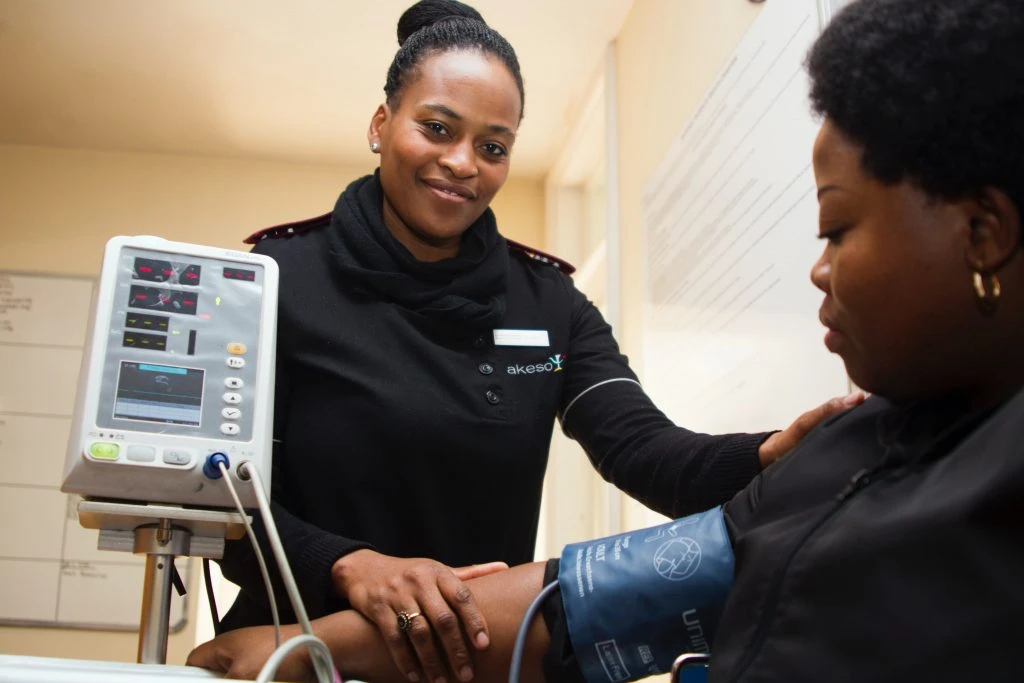
Program Specifics Include:
- Training and employment of over 300 residents for immediately available contact tracing related positions, with a focus on helping residents get on long-term career paths.
- Majority of positions are contact tracers, but the project also employs a care coordination team of about 40, which connects residents to needed social services, as well as operations support staff, supervisors, directors, managers, and career navigators to support the temporary contact tracer positions.
- Positions pay from $35,000 and up to $80,000 for the highest-level positions, and each includes a stipend to cover health benefits. Most last for eight months.
The project team carefully crafted new rubrics for screening and rating candidates prior to opening the job portal in June. The purpose of the rubrics is to eliminate barriers and bias in the process, while increasing equity and access to disadvantaged populations. These include detailed directions for applicant pre-screening, resume review, group screening and breakout session rubrics, and a rubric for pre-recorded interviews.
Once resumes have been screened through the portal, those that receive middle scores in the rubric are invited to a group interview with behavioral questions, while those that are high-scoring receive a link to pre-record an introductory interview, which will later be reviewed by staff.
The emphasis of the selection criteria throughout the interview process is on customer service and the ability to display empathy, as well as any other transferrable skill sets. This process provides opportunity for those middle scores to still advance in the process, with some being referred to shortterm upskilling programs, rather than being immediately referred to other programs and services outside of the Baltimore Health Corps.
Once hired, individuals in contact tracer positions begin two weeks of in-person training, and then their work is conducted from a centralized office building location until they are comfortable and competent with the contact tracing platform, after which they may opt to work from home. New employees are provided with a laptop and cell phone.
The provision of equipment is an equity strategy to ensure that some of those most at risk in the pandemic have the tools they need to be employed. Positions also come with employee supports, provided through MOED, including career navigation, financial empowerment counseling, and free behavioral health and legal services.
For a select number of applicants (up to 100) who show potential but might not yet ready for the contact tracer positions, the initiative offers a four-week community health worker training to help strengthen their candidacy. Completers are recommended to employers for priority recruitment, which serves as yet another equity strategy for upskilling local residents.
Key Partnerships:
The Baltimore Health Corps initiative is driven by critical partnerships. Key partners and their roles include:
- Mayor’s Office of Employment Development is the primary workforce agency, providing planning and staff for the recruitment and screening structure, career navigation, and connection to behavioral health support and legal services (offered through with Catholic Charities and Maryland Volunteer Lawyers Services).
- The Baltimore Civic Fund serves as the fiscal sponsor and provides assistance with fundraising and funding consolidation that supports streamlined relationships between funders and the city.
- Baltimore Corps conducts recruitment, providing the application website and the recruitment structure.
- Mayor’s Office of Performance and Innovation provides strategic and project management support.
- Jhpiego provides operational support to the Health Department, along with acting as a training partner for contact tracers and providing structure for performance monitoring.
- The University of Maryland School of Public Health is evaluating the program and will conduct a process study and summative evaluation.
- They are working on final outcome measures and supporting the team by providing a summary of performance metrics.
- The Baltimore Innovation Team (i-team) is supported by Bloomberg Philanthropies which awards cities multi-year grants to create highly skilled in-house teams that are dedicated to solving big problems in new ways — from reducing violent crime to revitalizing neighborhoods to strengthening the growth of small businesses.
The full list of partners and funders for this project include:
- Abell Foundation
- Annie E. Casey Foundation
- Baltimore City Health Department
- Baltimore Community Foundation
- Baltimore Ravens
- Bank of America
- Jacob & Hilda Blaustein Foundation
- Bloomberg Philanthropies
- BGE
- CareFirst
- France-Merrick Foundation
- Goldseker Foundation
- BACH (Baltimore Alliance for Careers in Health)
- Baltimore City Health Department
- Baltimore Civic Fund
- Baltimore Corps
- Catholic Charities of Baltimore
- HealthCare Access Maryland
- Jhpiego
- Maryland Volunteer Lawyers Service
- Mayor’s Office of Employment Development
- Mayor’s Office of Performance and Innovation
- Univ. of Maryland School of Public Health
Funding:
The total cost of the initiative is $12.44 million. This public-private partnership was mobilized by a $3 million commitment from The Rockefeller Foundation through its Equity & Economic Opportunity and Health teams. The City of Baltimore has made a $4.5 million commitment to support this initiative, tapping into its CARES Act Funds.
Additional private funders and local institutions have contributed more than $3.6 million in support and include the Annie E. Casey Foundation, Bloomberg Philanthropies, CareFirst BlueCross BlueShield (CareFirst), the France-Merrick Foundation, the Goldseker Foundation, OSI — Baltimore, the PepsiCo Foundation, the Rauch Foundation, the Stulman Foundation, and the T. Rowe Price Foundation. The city will continue to raise the remaining $1.3 million as the project moves forward.
Key Challenges:
Rapid partnership building
MOED and the Health Department had not previously worked this closely before on a combined effort at this scale. The entire initiative was built on leveraging virtual tools such as Zoom and Webex, from remotely coordinating partnership alignment and communication to recruitment efforts.
Prior to the pandemic, the Health Department had not previously relied on the workforce system for hiring needs, and did report having struggled at various times with recruitment and identifying applicants who meet the needs of a specific position but had not aligned themselves with the workforce system.
Through this new program, the Health Department expressed their satisfaction with the candidates that have been onboarded and working for a few weeks now. Baltimore Corps’ work to identify candidates who would be successful in this environment has been pivotal to their success.
The Health Department would recommend to other similar departments that are uneasy at taking on this challenge that it really has been an incredible experience, they are very happy and pleased with the results thus far and are looking forward to continuing the relationship.
Communicating vision to existing program staff
Developing processes for a large recruitment and placement initiative while not greatly expanding staff numbers (FTEs) could have been daunting to existing staff. Leadership developed a clear plan for weekly recruitment process flow and spoke directly with team members about the importance of the mission and value to the community. As a result of sharing the broader community vision, they were able to engender a sense of shared ownership and buy-in from staff as they launched the program.
Aligning communication strategy
Aligning a large multi-partner communication plan can be challenging in the best of times. At the outset, the Public Information Officers for each organization came together to engage their preexisting Joint Information Center (JIC) and worked to align their communication efforts. It had existed prior to the project; and, it was effectively leveraged in a virtual environment to coordinate the rapid building of this effort.
The Health Department took a lead role, along with MOED and Jhpiego, to get the word out to partners, and to the public through public virtual town halls, and at all relevant events held throughout Baltimore City. Additionally, they employed the use of multiple social media outlets, such as Twitter, Facebook, and Instagram. Partners met weekly, and shared information frequently across major program components, and continue to check in regularly as needed.
Summary of Project Impact
The team has received 4,500 applications since the program launched on June 4, 2020. As of November 6, over 200 applicants have accepted offers to join the Health Corps, and nearly 175 have already started their temporary positions with HCAM and the Health Department. To serve these staff, the Mayor’s Office of Employment Development hired five career navigators and placed approximately 100 participants into community health worker (CHW) training through the Baltimore Alliance for Careers in Healthcare.
The program team has contracted with University of Maryland School of Public Health to act as external evaluators. They will track standard workforce metrics as required by their grants but are looking to move beyond the traditional measures. They are also evaluating the public health contracting side of the project, as well as care coordination. The team will also conduct a post-intervention analysis to determine if the Health Corps program led participants to long-term employment within a health care career pathway.
Adapt This Approach:
Cost and Time Commitments:
From initial award to program launch, this program took six weeks. The rapid pace was driven by high COVID-19 case volume in the late spring and summer and a recognition of immediate need. The time and resources required to implement this model will depend on a variety of factors including:
- Availability and flexibility of funding streams
- Flexibility of existing team to work overtime and adaptability to shifting priorities
- Existing relationships and coordination with partners
- Community support and outreach strategies

Do:
- Do borrow from other models and adapt to local context.
The team leveraged the Massachusetts Partners in Health model to develop their contact tracing hiring strategy to allow for an explicit focus on rapid re-employment of the unemployed. They could have focused on quickly hiring the highest level of education possible, but their local commitment to employing dislocated workers with an equity lens required different strategies. The team believes the Baltimore Model is a promising and adaptive approach for other cities looking to expand their contact tracing capacity while addressing their jurisdiction’s economic and social needs. - Do engage employers throughout the process.
Because of the focus on upskilling participants and putting them on the road to clear career pathways in health, the team made the employer partners a part of the entire process — from weekly meetings to keeping them informed of participants’ training status. They were, of course, a key partner to the initiative, but their full engagement helped to drive the success of the recruitment process, and, in this way, demonstrated the key benefits of employer alignment. The employers’ public health expertise informed the program design and ensured that participants will come out of the program with the skills needed to go into full-time employment within an industry career pathway. - Do begin with a diverse and connected project management team.
The core team at Baltimore City included workforce experts, epidemiologists, community health work practitioners, and managers across each of the program objectives. Through these diverse viewpoints and early, open dialogue about program aims, the team was able to align its workforce and public health aims towards creating the most effective program possible. The team began by developing a solid operational framework that leveraged existing partnership organizations to support rapid implementation. The larger core project team across partners included leaders from all of the aligned organizations, totaling between 45-55 members.
Don’t:
- Don’t rely solely on traditional funding strategies.
Alignment of private funds and CARES Act funds, with a small portion of dislocated worker funds, provided the program team the flexibility to move ahead with recruitment and hiring for positions quickly to respond to urgent demand. Flexible funds also allowed Baltimore to contract for legal and mental health service supports quickly, and to support CHW training. - Don’t rely on traditional hiring strategies.
The Health Department partnered with the workforce team to craft job postings with no education requirements, which opened the process to a wide swath of the community. They also expedited their hiring process by working closely with Baltimore Corps and Jhpiego, employing the use of their existing online platform for screening candidates, and by developing a clear rubric and comprehensive plan for interviewing, training, and hiring.
Case Study #2
Train for Jobs SA, San Antonio, TX
Program Overview:
- Training stipend of $15/hr
- Up to $450 per week
- Up to 10,000 residents by September 2021
- Anticipate 80% receiving wraparound support
In May 2020, Workforce Solutions Alamo (WSA), in partnership with the City of San Antonio and Bexar County, established Train for Jobs SA, a training program designed to quickly upskill dislocated individuals for high-growth industries and occupations.
In addition to free training, participants also receive weekly stipends and significant wraparound services to support successful completion of the program and then placement into a job. The program was made possible through the commitment of the City of San Antonio and Bexar County officials who prioritized workforce development as their leading strategy to guide the city into and through recovery from the pandemic.
The overall goal of the program is to provide economic stability for those who are displaced as well as ensure the talent needed to support local industry is available as businesses begin to recover. Train for Jobs SA aims to serve up to 10,000 San Antonio and Bexar County residents by September 2021.
Eligible participants enroll via phone, and once in the program, complete a skills and career assessment. Participants may then be enrolled in high school equivalency preparation, or short-term, long-term or on-the-job training, all of which are aligned to in demand occupations in the city’s target industries and growth occupations. There are a myriad of training courses available, both on and off of their Eligible Training Provider List (ETPL).
Qualified participants are eligible to receive stipends of $15/hour (for between a minimum of 6 hours and a maximum of 30 hours per week) for actual time spent in an approved training program, up to a maximum of $450 stipend per week. The stipend is made available for the full length of the training, with a focus on participants attaining new skills or credentials and keeping them engaged after the training to advance on a career pathway.
Train for Jobs SA is also a key driver supporting the City of San Antonio’s long-term goal of decreasing economic segregation. The program developed and uses an equity matrix questionnaire to identify participants in specific areas who are more at risk and prioritize them for enrollment and additional services.
Up to 80% of program participants are anticipated to receive comprehensive wraparound support such as case management, career navigation, and connection to other Workforce Innovation and Opportunity Act (WIOA)-funded services.
Key Partnerships:
Key partners for this project include:
Funding:
Funding was awarded to the Train for Jobs SA program in the amount of $12 million, with $8 million provided by the City of San Antonio General Fund and $4 million in Coronavirus Relief funding. Although they have received significant disaster grants, this program is separate and fully funded by city and county dollars. Co-enrollment and alignment with WIOA-funded programs is encouraged where appropriate.
Key Challenges:
Shifting to virtual delivery
Train for Jobs SA is working to improve virtual onboarding and orientation for participants. The project team is piloting online open sessions for orientations and the development of a video tutorial on how to sign up for services, to accompany the registration site.
Partner referrals and participant awareness
WSA noted that building system and public awareness is an ongoing challenge with any new program, yet it is critical to support referrals into the program. To address this challenge, the WSA team has launched a multi-modal messaging effort, including social media outlets such as Facebook, Twitter, Instagram, and numerous websites, to increase overall public awareness as well as reach specific populations targeted by the program.
Summary of Project Impact
With the start of the program in mid-August 2020, and active participant recruitment beginning in September, intake is active and ongoing. The team has developed a set of goals and measures for the project that include by September 2021 an anticipated: 4,000 assessed, 1,750 receiving case management services, 1,400 receiving short-term training, 100 receiving long-term training, 1,500 receiving stipends, and 1,000 placed in on-the-job training and employment. In the first five weeks of the program, 78 participants were placed in shortterm training, and 21 in long-term training.
Adapt This Approach:
Cost and Time Commitments:
With strong support from the Mayor’s office, funding was awarded during the summer and the program began in mid-August. In alignment with citywide equity goals, and more flexible funding streams, they were able to stand up a new, large program in a matter of weeks, and the program launched at the beginning of September. The time and resources needed to implement this model will depend on a variety of factors including:
- Flexibility of funding streams
- Buy-in and adaptability of partners
- Ability to borrow from existing tools and structures
- Availability of staff

Do:
- Do start — and proceed — with good data.
Prior to COVID, WSA determined high-growth occupations and identified the target industries that aligned with economic development goals for the region. Although WSA is operating under the assumption that many industries will return to previous employment levels post-COVID, they are also using real-time labor market information and job postings (such as Burning Glass and Help Wanted Online data) to monitor monthly shifts and pivot their training investments accordingly. - Do identify training providers upfront.
Provide as many options as possible by broadening the training provider pool and expanding the ETPL. By expanding the list of programs to include short-term as well as long-term, increasing the variety of training to all of the regional industries in demand, and increasing flexibility in training schedules, the program can become relevant for a broader array of participants. Training providers are a critical part of the planning process and can support workforce staff in identifying training gaps more quickly. - Do focus on program awareness.
Focus just as much on partner and staff awareness as participant awareness in your outreach campaign. Intentionally messaging the availability and value of services provided and quickly establishing an efficient process to drive program referrals will shorten the time frame between program design and participant enrollment. - Do focus on building trust between local elected officials and the local workforce board.
A key to success of this project has been the positioning of the local workforce development board (LWDB) as a natural leader in the region. The LWDB is seen by local elected officials (LEOs) as a trusted entity with the ability to analyze unemployment data as well as real-time data to help officials better assess the current situation and those most impacted by the pandemic. - Do incorporate strategies to reach equity goals.
The City of San Antonio uses an equity lens to prioritize investments and policy decisions. As previously noted, Train for Jobs SA uses an equity matrix to target key populations for recruitment and provides extensive support and wraparound services to drive successful program outcomes.
Don’t:
- Don’t rely solely on traditional funding strategies. A key to standing up the program in short order has been the ability to identify flexible funding streams that allow financial resources to be implemented quickly and in an innovative manner. The board worked directly with the Mayor’s office and other local city leadership to make general fund dollars available to support this program.
Resources:
- Train for Jobs SA informational site
- Participant site
- Workforce Solutions Alamo site
- San Antonio equity maps
- San Antonio, TX press release – $2 Million Dislocated Worker Upskilling Grant
- San Antonio, TX press release – $450 Stipend for Retraining
Learn more about the Workforce Tactical Guide
COVID-19 Economic Response and Recovery
Increase Broadband Connectivity to Enable More People to Work Remotely and Support Business Growth
Problem:
The COVID-19 pandemic has underscored the importance of broadband access for employment, education, and overall quality of life. And yet, millions of Americans don’t have access to quality broadband (defined by the FCC as 25 mbps download and 3 mbps upload speeds). At least 21 million Americans (and perhaps as many as 40 million, according to some estimates) currently lack access to broadband; and, even among those Americans with access, approximately 100 million do not subscribe to the service. Improving access not only enables remote work but can increase property values.
While many jobs will return as “in-person”, an increasing number of companies have said they will focus on remote employment. COVID-19 forced millions of Americans to work from home and attend remote classes. Some businesses are realizing that their employees can successfully work remotely, and save related costs from doing so. Schools face uncertain paths to reopening with many districts using remote schooling for the foreseeable future. To address these fundamental changes, cities will need to ensure that all residents have access to broadband. This means both building the physical infrastructure and ensuring affordability.
Action:
Cities should provide broadband access to all residents through 1) extending broadband physical infrastructure and 2) providing funding for low-income residents to receive broadband. This will enable residents to work remotely, local businesses to compete at a larger scale, and students to receive remote education.
Facilitating access to broadband requires different solutions depending on local circumstances. For some communities, there are issues with physical broadband infrastructure. For others, most residents have access but are unable to access it due to affordability. The latter can be addressed through direct or indirect subsidies.
Case Study
Wilson, North Carolina: Greenlight Community Broadband
Wilson, North Carolina (population ~50,000) was facing an uncertain and troubling economic future. The decline of the manufacturing and tobacco industries had impacted their economy and lack of job availability was causing many to leave the City. Recognizing that it needed to adapt to the changing employment landscape, the town decided to prioritize broadband installation to enable people to work remotely. Wilson met with its local cable provider and tried to convince them to expand access. But the cable company explained that it would be impractical to install high-speed internet because the City was not densely populated. After declining the City’s offer to handle the cost, the company “laughed” at Wilson’s suggestion that it would build its own wifi network. That prompted the City to create the “first-gigabit city”, establishing the Greenlight Community Broadband to provide broadband to the entire community.
After attempting to find partner companies, Wilson proceeded to build the network itself. The City borrowed $33 million to build the system, finishing construction and providing internet to the entire City by 2009. All schools have 100 mbps (or more) and the entire community is able to access gigabit speed. Greenlight is on track to pay back its loans on time.
Since providing the gigabit internet, Wilson has seen a significant increase in economic development, with businesses moving to the City and people able to more easily work remotely. Barton College has been able to attract better students, develop advanced curriculum, and better place students into jobs. Additionally, the launch of Greenlight has led to competitor prices dropping in the City. A study found that the community saved $1 million per year from more affordable rates because of Greenlight, while broadband rates have consistently increased in surrounding areas. Greenlight’s price for a 100 mbps internet connection is less than what some individuals in nearby communities pay for 10 mbps. Greenlight is community-owned and provides the full range of broadband services (e.g., installation, repair, etc.) to the community.
Note: Broadband deployment regulations vary by state. Some, such as North Carolina, prohibit municipal broadband and have prohibited Greenlight’s expansion into surrounding communities. However, there are several options to consider when deploying broadband. For some communities, short-term access can be provided through subsidies and mobile hotspots. One non-profit, Connected Nation, works with local communities to identify demand for broadband then presents this information to broadband providers to show the business case for broadband expansion. Their work expanded broadband availability in Kentucky from 60% to 95% of households.

Case Study: Balanced Public-Private Partnership
Westminster, MD: Carroll County Public Network (CCPN)
Westminster, Maryland (population ~18,000) had significant issues with broadband access and many residents lacked access. To facilitate access, the County, Public School System, Libraries, and Community College formed the Carroll County Public Network (CCPN) to focus on improving access. CCPN partnered with Ting – an internet service provider – to provide access to its residents. Westminster is responsible for network construction and owns all fiber infrastructure. Ting provides service to residents and leases access. After an initial exclusivity period, competitors will be allowed onto the network.
Initially designed for only businesses, the network has since broadened to include residents due to its popularity. Adoption rates have been high and one IT company even moved their operations to Westminster – a town of 18,000 residents – because of the improved connectivity and other low costs. The agreement requires Ting to answer all customer calls with a human representative.
How To Adapt this Approach:
A. Physical infrastructure
- Assess where gaps in broadband access exist due to lack of physical infrastructure
- Gather data on the potential upside to companies to expanding broadband access
- Survey residents to determine who has broadband
- Determine if there are “shovel-ready” projects that the city can act on immediately (e.g., projects where planning and approval have already been completed for wiring installation).
- Similarly, cities should explore “dark fiber” networks, where bandwidth on existing broadband networks are not being used to their full capacity (e.g., by corporations, universities, military, etc.). Newark, NJ has used this model to expand broadband access.
- Explore funding options and consider the different options for expansion
Municipal-owned broadband (e.g., Wilson, NC) -> broadband run by the city (more information below). This may be prohibited by state regulations.
State funding programs: some states such as Wisconsin’s Broadband Expansion Grant Program, allow a city and broadband provider to apply jointly.
Public-private partnerships:
PPPs related to broadband have varying degrees of public-sector involvement from private-led investment and minimal public sector support.
The government can take a leading role in construction (e.g., financing, constructing) and own the network, having private companies facilitate access.
Balanced partnerships where private and public sector entities share benefits and risks.
What model makes sense for your city depends on the funding available for the expansion, private-sector and philanthropic partners available, and local expertise. The degree of public-sector involvement should be determined based on the risk exposure your government is willing to assume. Often, balanced PPPs are pursued as a way to both retain public ownership and minimize risk. - Launch physical broadband expansion, prioritizing areas with “shovel-ready” projects
- Track progress and revise as necessary
B. Subsidies
- Determine # of people who do not have broadband access due to lack of affordability
- Broadband providers often have data on who has not subscribed
- Note: some people do not subscribe to broadband because they have other ways to access data (e.g., 3-5G on their mobile); however it can make it challenging to perform more broadband-heavy tasks (e.g., video calls).
- Work with broadband providers to see if complimentary access can be provided
- Providers offer broadband to low-income Americans who qualify (generally eligibility is based on income levels and/or participation in certain programs), costing as little as $10/month. Many are unaware of this offering.
- Evaluate funding options
- Ask broadband providers if they are willing to extend access, especially during COVID times. The cost to these providers is negligent if access already exists in the building/area.
- Consider potential philanthropic partners to support this effort.
- Work with city council to meet short-term broadband needs for low-income residents.
- Funding should be provided until 1) businesses reopen and people can return to work and 2) schools reopen.
- Subsidies for a high number of residents could be significantly below cost (e.g., $5/month per customer or less). Broadband companies will want to set up many new accounts so there is a substantial upside here.
- Pay broadband companies directly to avoid additional bureaucratic work and potential economic harm while waiting for reimbursement (e.g., do not require residents to pay and request reimbursement).
- Launch effort to inform residents of the new broadband subsidy program.
- Be sure to focus on low-income and communities of color
- Track adoption rate and progress, altering program as necessary.
- If possible, offer discounted access to new entrepreneurs (those with 0 employees).
- Ensure that cost is tracked and that broadband does not become unaffordable

Benefits:
- Ensures equitable recovery by enabling people to access jobs that may not be in their immediate area
- Avoids health risks of travel (e.g., on public transit)
- Enables businesses to be more competitive by offering lower-cost and more reliable services in the community
Risks:
- Costs can be high when facilitating access in more isolated communities
- Affordability can become a long-term cost if steps are not taken to work with businesses to lower costs and facilitate access
Impact: High
Implementation time: Slow (subsidies), L (physical infrastructure)
Cost: High. It will cost millions to expand physical infrastructure for broadband or issue subsidies. You can expect to pay at least ~$5-$10/month for subsidies for each family without the internet. Actual costs will depend on local circumstances.
Learn more about the Toolkit
Action:
Help small businesses to pivot, adapt, and capitalize on new opportunities in a COVID-19 world.
Why:
Keeping spending local is critical for economic recovery. By helping businesses meet the needs of surging resilient sectors, develop new sales channels, or create new lines of business; you are creating longer term revenue solutions than subsidies and loans.
Case Study #1
Personal Protective Equipment (PPE) Grant and Procurement Fund – Baltimore, MD
In April 2020, the Baltimore Development Corporation (BDC) established two funds to help Baltimore manufacturers meet local demand for PPE by frontline workers and residents.
BDC created a $150,000 PPE Grant Fund to help manufacturers off-set costs to convert operations to PPE production. The fund awarded grants of up to $15,000 to fund equipment modifications, materials, and labor associated with the manufacturing of specific PPE needs identified by public health officials.
BDC’s ability to engage local manufacturers rapidly was aided by the Made In Baltimore program, which had built communication channels and trusted relationships prior to the pandemic. The program helped to identify and vet which businesses would be able to handle a rapid emergency pivot and response.
Critically, the City allocated $400,000 for a Local Procurement Fund to purchase locally made PPE for frontline City workers. The fund was administered by BDC, which streamlined the procurement process, thereby creating immediate demand for makers and kept City procurement dollars local.
In terms of impact:
- The grant fund supported 15 businesses, 53% of which were women-owned and 33% minority owned. It supported the production of 84,000 masks, 30,000 face shields, and 33,000 gallons of sanitizer.
- The procurement fund contracted 6 businesses, 50% of which were minority-owned or led. It procured 45,000 face masks, 2,500 face shields, and 16,200 isolation gowns.
Case Study#2
Resurgence Small Business Fund – Atlanta, GA
In August 2020, Invest Atlanta, the City’s economic development authority, launched a $17 million fund providing grants to small businesses trying to safely reopen and adapt to the COVID-19 environment.
Eligible applicants can be awarded up to $40,000 and an additional $10,000 for technical assistance in finance, legal, workforce, and technology from 13 business support organizations contracted by the City.
The Resurgence Small Business Fund is weighted towards businesses that are in lower-income communities, MWBEs, long-term growth sectors, longevity of business in Atlanta, those that have not received other COVID-19 relief, and businesses who have demonstrated planning for reopening and adaptation to COVID-19.
It is funded through the CARES Act, and grants are provided on a reimbursable basis.

How to Adapt This Approach:
- Assess the needs of small businesses in the community with a particular focus on which groups of small businesses and neighborhoods are facing the greatest challenges
- Identify the adaptation need/opportunity (e.g., setting up an e-commerce website, retooling equipment to produce PPE, adapting outdoor seating for winter months, etc.)
- Identify which small businesses the program will be designed for. Determine if the fund will focus on supporting all MWBEs; businesses located in LMI areas; a specific sector or business type or some other criteria of need
- Identify and develop philanthropic and/or corporate partners to financially support the program. Leverage City funds to draw in this outside match
- Work with a local CDFI or other nonprofit partner to administer the program, or manage the program directly
Create the program parameters (loans, grants, size, use, terms, eligibility criteria, etc.) based on the City’s policy goals, input from program partners and local stakeholders. Examples of program parameters: Baltimore PPE Fund, Atlanta Resurgence Fund - If applicable, leverage the City’s procurement powers to purchase goods and services from businesses who receive support from the program
- Partner with trade groups, local/ethnic chambers, and other business organizations, which are trusted partners in the communities where the program is focused, to lead outreach, and promote it
- Leverage technical assistance partners to help targeted small businesses apply to the fund
- Maintain a reasonable (e.g. 3+ weeks, include pre-noticing, not first come first serve) window for application submission. Assemble an inclusive application review committee to make award decisions.
- Evaluation criteria could include:
– MWBEs
– Businesses that did not receive CARES Act or other COVID-19 relief funding
– Businesses located in LMI communities
– Businesses with a plan to reopen or adapt to the post-COVID environment
– Length of time operating in the city
– Sector - Add all applicants into a centralized business support database/client relationship management tool (CRM) to coordinate future support
- Provide wrap around technical assistance to businesses who receive funds as well as those who do not
- Track and publish KPIs on a regular basis. Include aggregated demographic and neighborhood data on applications and awards. (See KPIs section)
- Keep partners, particularly neighborhood stakeholders and local business groups updated on progress and any challenges
- Track lessons learned and incorporate into future programming
Learn more about the Tactical Guide
COVID-19 Economic Response and Recovery
Establish a Midsize Business Support Program (e.g., up to $250k loan)
Problem:
Many communities offer programs to start businesses, but less support is given to businesses looking to expand. Access to credit can be difficult, and many large contracts require surety bonds or other guarantees. Yet, businesses with 5-99 employees are critical to the US economy. They account for 29% of all jobs and are often the bedrock of US cities. Supporting these businesses enables them to scale and meet more of the community’s needs. In turn, this expansion creates more jobs and keeps more spending local. Given the growing concerns of the plight of small businesses and the associated economic and employment risks, providing support to help them maintain and expand operations will be critical. This will also help address unemployment and should be done in conjunction with reskilling programs.
Action:
Cities should provide loans through a government-backed fund to help midsize businesses expand and be able to compete for larger government and enterprise contracts. Additional access to capital should be provided as part of a broader program that offers guidance for businesses (e.g., through an entrepreneurial ecosystem).
Case Study
San Francisco, CA: Surety Bonds Program
San Francisco created a surety bond program to enable local businesses to compete effectively for government contracts. For local businesses that need funds to compete for government contracts, the city government will guarantee up to 40 percent of the face amount of the bond, or $750,000. Launched in the mid-1990s, the city started the surety bond program as a pilot program for their international airport expansion project. Based on the positive feedback and success from the pilot, the city established the broader surety bonds program.
The Surety Bonds program was established as a complement to the local business preference program and enables small businesses to compete for government contracts. As long as a business has been deemed eligible, they can apply for the surety bond. All city departments contribute a certain amount of their contracting budget to provide the guarantee for the bonds. Despite concerns about the potential cost of the government having to guarantee loans, only 2 projects with a surety bond have defaulted in the 20+ year history of the program.
Part of this success is due to the associated technical assistance. Most businesses that are receiving support are required to attend the bonding assistance training program. This programming includes assistance for completing bond applications and the pre-bond surety profile, help developing financial statements and establishing internal financial control systems, and how to implement accurate financial reporting tools.
Note: Although the program does not have defined metrics, the attached document highlights what should be considered with implementation. This includes tracking the # of businesses that apply for the program, the number of businesses awarded surety bonds, how many successfully win contracts, and long-term benefits (e.g., if a business is able to compete for other large contracts in the future).
While the San Francisco program focuses on city procurement and government contracting, cities should design programs that assist businesses in contracts with anchor institutions and other large corporations based in your city. Programs can be launched with a focus on government contracting – which may be easier to set parameters for – but with a goal of expanding for all larger contracts in the community.

How To Adapt this Approach:
- Meet with local businesses to understand the existing markets and landscape, and identify opportunities for growth.
- Discuss barriers to growth (e.g., why they are not competing for larger contracts, what they would need to be successful)
- Design program parameters (e.g., maximum loan amount, whether for all government contracts, etc.)
- The program design will vary by local circumstances. Elements to consider include:
- Maximum loan amount: in some cities, a $50K loan cap will be sufficient to enable businesses to expand and compete for larger contracts. For other places, this may be closer to $250K. During discussions with local businesses, review what would be necessary. Loan terms should be long-term, with low-interest (e.g., 2% over 10+ years)
- Government vs. private sector contracts: it may be easier to start with government contracting, but ideally this program would also help the businesses to compete for private-sector contracts.
- Determine the eligibility of businesses (easier if linked to a small business preference program)
- Raise funds to cover surety bond guarantees (for public sector contracts). Surety bonds are often required for public sector projects as a promise that the work will be performed. Getting a bond can be challenging for growing or newer companies as it is often contingent on previously performing projects of a similar size. Cities can raise funds for surety bond guarantees by requiring a certain percentage of each department’s contracting budget to go towards this.
- The program design will vary by local circumstances. Elements to consider include:
- Build oversight and technical assistance capacity (which can be added on to existing technical assistance services). As businesses take out loans, it will be necessary to support them, while ensuring the funds are being used correctly.
- Some businesses may not have applied for any significant loan or financing before. Walking them through this process, and ensuring compliance, will be key.
- This office should also help with bond applications, basic financial controls, and reporting requirements.
- This office does not need to be housed within your city’s economic development agency. It may be better housed within an existing city department.
- Draft program language and propose it to city council and other key stakeholders. (See template in resources section)
- Pilot a small version of the program. The full program could be expensive and will require considerable oversight.
- Collect learnings from the pilot and launch the broader program.
- Ensure that businesses are paid on-time and that there is sufficient oversight. Some cities require local businesses to be paid within 30 days of contracts.
- Track action progress and success, and revise as necessary. (See template in resources section)

Benefits:
- Enables local businesses to access funds and expand faster
- Offers flexibility for businesses, particularly if they are applying for larger government or commercial contracts
- Investments in growing local businesses can provide significant job growth for local communities
Risks:
- Assume financial risk of supporting loans
- Can be problematic if offered without support programs (e.g., financial counseling, entrepreneurial culture)
Impact: High
Implementation time: Medium (pilot), Low (full program)
Cost: High. Although the actual cost of the program may be lower (e.g., issuing loans and receiving payback) it will seem high because it requires expenditures each year, even though it will be repaid. If offering loans between $50K – $250K, and assuming several FTE to run the program, it could cost over a million a year even for a smaller program.
Learn more about the Toolkit
COVID-19 Economic Response and Recovery
Give Preference to Local Businesses for City Contracts
Problem:
Local businesses in particular have been devastated by COVID-19. One in four small businesses have considered closing due to the pandemic, and many others are facing significant challenges, unlike anything they’ve experienced. City contracting is a powerful tool for driving local demand but small businesses are often unable to compete for contracts because of a lack of awareness about the contracts or the bid process, insufficient funds to compete, and/or concerns about reporting requirements.
Action:
The City should provide a preference and/or discount for local contractors in its procurement process. By increasing the amount of purchasing at local firms, this action will help maximize the local multiplier effect which is critical, particularly during the deepest parts of the recession. A similar but distinct program should be created for minority-owned businesses, given the persistent disparities. However, this action will only be successful if it is done in conjunction with several others included here, including creating a more entrepreneurial ecosystem, providing funding to help scale, and actively reaching out to prospective local businesses.
Case Study
San Francisco, CA: Local Business Enterprise Program
The City of San Francisco has implemented a local business enterprise (LBE) preference program that is designed to increase the number of government contracts going to local small businesses in the city. The program — enacted carefully to be in accordance with state and federal contracting laws — enables local small businesses to compete for contracts. The local business enterprise preference program was accompanied by strong technical assistance. It was implemented after a 2004 State Superior Court decision ruled that the previous local business preference program had violated Proposition 209, a local ordinance prohibiting discrimination based on race.
The new local business preference program was formed with this context in mind and focuses on goals for engaging local businesses. The Mayor sets a goal for the City every year and the City provides bid discounts, set-asides, and subcontracting opportunities to make it easier for local businesses to win contracts. There is also a Human Rights Commission which is focused on increasing minority-business engagement.
San Francisco created a free LBE certification process to determine eligible businesses. The city provides a 10% discount on bids for government contracts. The 10% threshold was chosen after the city conducted a disparity study to determine an appropriate rate to counteract lower prices that larger corporations may be able to provide.
To be certified, a business must maintain their principal place of business within City limits and have a majority of principals based in that office. They must also pay at least 51% of their payroll taxes to the City to demonstrate that a majority of their employees are based in their city. The City defines eligible businesses as local small businesses if their average gross annual receipts in the previous three years do not exceed several set limits: (1) public works/construction – $14,000,000; (2) specialty construction contractors – $7,000,000; (3) goods/materials/equipment and general services – $7,000,000; (4) professional services and architect/engineering – $2,500,000; and (5) trucking – $3,500,000. A City office has been given responsibility for review and enforcement and review of these limits. The City has also linked this initiative with its Surety Bonds program to enable small businesses to have a better chance of winning government contracts (this action is included later in the toolkit).
One of the biggest challenges that the City has encountered is ensuring that small businesses are able to complete contracts. Some business owners have never applied for a government contract, nor completed a large-scale project. To address this, the City provides significant technical assistance during the certification process and facilitates connections to other entrepreneurs who can provide insights into this work.
Other Examples:
Chicago also has several programs to support local businesses and advantage them during government procurement processes. The Mid-Sized Business Initiative (MBI) is designed to enhance procurement opportunities for midsize businesses to work with Chicago. The program sets aside certain construction contracts to be made exclusively available to qualified, midsize, local businesses. There are two tiers of contracts: MBI-1 projects with an estimated value of between $10 and $20 million and MBI-2 which are $3 and $10 million in size. To qualify, a business must meet several requirements, including qualifying as a midsize business. This program focuses on construction, but the city has also created a non-construction version, the Non-Construction Mid-Sized Business Initiative (NMBI).

How To Adapt this Approach:
- Determine the type of preference your city wants to provide (e.g., discount in scoring vs. actual set-aside in terms of % of contract)
- Assess the percentage of current business (in terms of contracting dollars) that goes to government contracts and set a target for how much spend should be prioritized for local small businesses.
- How your city does this may be dictated by state law. Some states forbid specific set-asides for local contracts. If your state has strict rules, you should consult your city’s attorneys. Some cities may need to frame this action as a preference for “familiarity with local environment” to be compliant with state regulations.
- Discuss with local business leaders to get feedback on the proposed program
- Draft administrative code language for local preference program (See template in resources section)
- Be sure to review with the city’s attorney and other officials
- Have strong enforcement mechanisms to hold companies accountable to requirements regarding subcontractors. This should include fines and the ability to end the contract.
- Establish parameters for the definition of a local business (e.g., majority of employees/principals based in the city). Determine which businesses are eligible based on size, revenue limit by industry, etc. These limits will vary according to local circumstances.
- Review the language with city council, city administrators, local business leaders, and other key stakeholders to confirm that it is satisfactory
- After passing, launch an outreach effort to familiarize local businesses and support them in their application process
- Reach out to relevant businesses and launch a communications effort to notify businesses of the program
- Establish a procedure to actively contact businesses about contracts that may be suitable for them
- Assign responsibility to government officials – and hire if necessary to augment existing staff – to provide technical assistance
- Track metrics on program performance with biannual sharing of data. (See template in resources section)

Risks:
- Raises concerns among larger businesses that compete with small and local businesses
- Needs to be accompanied by proper technical assistance for local businesses (e.g., access to capital, technical expertise) to ensure they are able to fully leverage opportunities
- Can cause problems for businesses looking to compete in surrounding communities (if all implement this)
- Could lead to higher cost of goods and services due to preferences which may mean more expensive suppliers, wages, etc.
Benefits:
- Keeps government spending local, reducing leakage and increasing overall economic activity in the city
- Supports local businesses and enables them to compete for government contracts
- Provides structured mechanisms for local businesses to obtain a reasonable advantage in contracting
Impact: Medium
Implementation time: Medium
Cost: Low. The preference program itself is not expensive, although it may require several FTE to provide technical assistance and oversight.
Learn more about the Toolkit
COVID-19 Economic Response and Recovery
Generate revenue by selling, or monetizing city-owned buildings, infrastructure, and other assets
Action:
Cities should explore ways to leverage real estate, enterprise, or physical city-owned assets to fund economic development programming.
Why:
Most cities own numerous real estate, infrastructure, and enterprise assets and have a concerted asset management program. However, this program does not usually prioritize investments/reinvestments which deliver economic development goals (which can yield longer-term returns for the city).
Cautionary Tale and Learning Lessons
- In 2008, the City of Chicago Mayor Richard Daley successfully lobbied for the approval of an agreement which privatized all of the parking meters in the City for a period of 75 years for an immediate $1.157 billion cash infusion (for a one-time payment towards the city’s unfunded pension liability). This agreement immediately drew the ire of the public who immediately saw escalating meter rates as well as the Chicago Inspector General at the time who proclaimed the agreement undervalued the system by $975 million. It is expected that by 2021, the initial $1.157 billion will be recouped by the private operator with 62 years left remaining on the lease. The agreement to commercialize Chicago’s Parking Meters is considered a case study in what not to do. As other cities such as Louisville, Indianapolis, and Cincinnati have considered commercializing their parking meter assets over the past 10 years, they have been much more cautious in their commercialization efforts.
- The International Monetary Fund (IMF) released an article in March 2018, which summarized how cities can unlock their public wealth by, “ doing a better job of managing their assets.” Specifically, as this relates to cities in the U.S., the article references Boston, MA and outlines how the city ban expects to achieve better performance (i.e. up to fourfold based on the research cited) by simply analyzing and reporting their existing assets return on investment (ROI). As such, the article projects that Boston could achieve a 3% return on its commercial assets by managing these more professionally and with independent oversight.
(Click here for more information on Cautionary Tale and Learning Lessons.)

Background:
City assets can include both physical real estate and enterprise (e.g., database) and physical infrastructure (e.g., street lighting).
Cities that are facing funding shortfalls should look at opportunities to monetize or privatize assets. In this way, they may be able to address short-to mid-term budget gaps, avoid layoffs and service cuts, fund new programs, and/or respond to a crisis or unexpected event.
City assets that are commonly commercialized include parking garages, parking meters, airports, landfills, utilities, and infrastructure assets, such as bridges.
Cities can commercialize these assets by
- Creating a public-private partnership;
- Doing a sale-leaseback, which both provides immediate funding and alleviates future maintenance and operation costs; and
- Utilizing them for immediate opportunities such as incubators/accelerators, shared workspaces, and maker spaces.
Best Practices from International City/County Management Association (ICMA).
Click here for ICMA Best Practices.
Cities should also consider whether a larger asset portfolio would be more attractive to partners. Cities may need to review existing regulations if they are to maximize the value of the assets.
Case Study
Surprise, AZ – TechCelerator
During the 2009 Great Recession, the city of Surprise, AZ (a suburb of Phoenix) created a technology incubator to support entrepreneurs. The incubator is housed in a 60,000 ft2, city-owned building, which had previously served as the Surprise City Hall. The city’s economic development team convinced the city’s management not to sell the property while the real estate market was depressed.
Instead, the team rolled up their sleeves and, with volunteers and a shoestring budget of $1,000, created the incubator. This involved making physical improvements to the building, reusing existing furniture, fixtures, and equipment, and assigning a part-time staff person to manage the facility.
The incubator offers start-up space, small business assistance, an incubator, affiliate services, co-working space, and global concierge services (soft landing for international businesses).
It also offers below market rent to local startups, as well as administrative support and access to advisers who help the startups “graduate” from the facility within three to five years. The hope is that these startups will then set up shop in the city of Surprise.
Impact:
It cost the city ~$6m less to repurpose an existing building, rather than build new. The incubator profits, which are in the range of $25,000 a year, are reinvested into start-up support.
Over 10 years, the incubator has supported 500 new technology jobs, and 50 new businesses, and it continues to be a viable venture.
